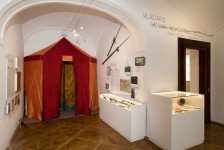Rulers, soldiers, craftsmen
From the end of the 10th century, the German-Hungarian administrative border in the Pomurje region was intersected by the Mura River to the north and the Kučnica River to the east. Prekmurje, as part of the Hungarian border-defence zone, was administratively divided into two counties. The Ravensko and Goriško belonged to the Iron County (Vas), centred in Vasvár and then Szombathely, and the valley part to the County of Zala, centred in Zalavár and then Zalaegerszeg. The protection of the defensive zone was first entrusted to the guards (riflemen), a militarily organised group enjoying certain privileges. In peacetime, in addition to cultivating the land, they controlled trade and had customs powers. With the grant of land, the feudal lords took over the defence. The land lords consolidated their economic and military power in castles, which were built from the 13th century onwards. By the end of the Middle Ages, the Counts of Stubenberg were the most important in the Styrian part of Pomurje, while in the Prekmurje part the Counts of Hahold-Bánffy, based in Dolnja Lendava (today Lendava) and Széchy, based in Gornja Lendava (today Grad na Goričkem), were the most important. Markets and towns became the centres of economic development, with Radgona being the most prominent of these.
The turkish wars
From the 15th century until the 17th, the greatest danger was represented by the Turks, who in 1479 broke through to Ljutomer for the first time. The organisation of the defence of the Austrian lands against the Turks was taken in hand by Archduke Ferdinand I, and in the 16th century Radgona became an important military supply centre.
In 1526 Ottoman forces defeated the Hungarians at the Battle of Mohács. The kingdom was divided into three parts, with the Habsburgs assuming the crown of Hungary. Turkish attacks on Prekmurje from Nagykanizsa, the seat of a pashalik, increased in the late 16th and in the 17th century. They lasted until the defeat of the Turks on 1 August 1664 at Szentgotthárd (St Gotthard). The final defeat of the Turkish army came in 1683 at Vienna.
Pilgrimages, Church Fairs and other Fairs
The celebration of the feast day of the patron saint of a church or chapel is a village festivity and social event traditionally marked by fairs and pilgrimages. People would travel on foot to nearby centres of pilgrimage such as Sveta Trojica (in the hill district of Slovenske Gorice), Turnišče and Veržej. Travellers would bring back various souvenirs from these pilgrimages and many believers would pray for good fortune at roadside statues, the work of folk artists.



.jpg)
.jpg)
